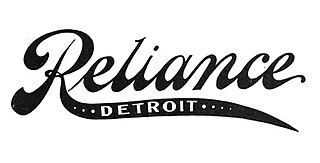
Georges Richard (1863–1922) was a French racing driver and automobile industry pioneer.

L'Aster, Aster, Ateliers de Construction Mecanique l'Aster, was a French manufacturer of automobiles and the leading supplier of engines to other manufacturers from the late 1890s until circa 1910/12. Although primarily known as an engine mass manufacturer the company also produced chassis for coach-works and a complete range of components.

Buffalo Electric Carriage Company was a Brass Era manufacturer of electric automobiles in Buffalo, New York.

Elmore Manufacturing Company was a manufacturer of veteran and brass era automobiles and bicycles (1893–97), headquartered at 504 Amanda Street, Clyde, Ohio, from 1893 until 1912. The company took its name from a small parcel of land in Clyde with the name Elmore associated with it where a stave mill was established originally, then evolved into bicycle production. The village of Elmore, Ohio is located 20 mi (32.2 km) to the east. Founded by Harmon Von Vechten Becker and his two sons, James and Burton, the Elmore used a two-stroke engine design, in straight twin or single-cylinder versions. They later produced a straight-3 followed by a straight-4 beginning in 1906 until production ended in 1912. The company advertising slogan was "The Car That Has No Valves", referring to the two-stroke engine.

The Mors automobile factory was an early French car manufacturer. It was one of the first to take part in automobile racing, beginning in 1897, due to the belief of the company founder, Émile Mors, in racing's technical and promotional benefits. By the turn of the century, automobile racing had become largely a contest between Mors and Panhard et Levassor.

Pope-Waverley was one of the marques of the Pope Motor Car Company founded by Albert Augustus Pope and was a manufacturer of Brass Era electric automobiles in Indianapolis, Indiana. From 1908 until production ceased in 1914 they became independent again as the Waverley Company.
Smith & Mabley was an American veteran era importer of European automobiles and produced the American C. G. V. automobile in 1902, and the S & M Simplex automobile from 1904 to 1907, in New York City.

E. R. Thomas Motor Company was a manufacturer of motorized bicycles, motorized tricycles, motorcycles, and automobiles in Buffalo, New York between 1900 and 1919.

The Yale was an automobile by the Kirk Manufacturing Company, a manufacturer of Brass Era automobiles in Toledo, Ohio, from 1901 to 1905.

The first Cadillac automobiles were the 1903 Model built in the last quarter of 1902. These were 2-seater "horseless carriages" powered by a reliable and sturdy 10 hp (7 kW) single-cylinder engine developed by Alanson Partridge Brush and built by Leland and Faulconer Manufacturing Company of Detroit, of which Henry Leland was founder, vice-president and general manager.

The Brew-Hatcher or B & H was an American automobile introduced in January 1904 at the Chicago Automobile Show and manufactured from 1904 until 1905.

The original Ford Model A is the first car produced by the Ford Motor Company, beginning production in 1903. Ernest Pfennig, a Chicago dentist, became the first owner of a Model A on July 23, 1903; 1,750 cars were made in 1903 and 1904 at the Ford Mack Avenue Plant, a modest rented wood-frame building on Detroit's East Side, and Ford's first facility. The Model A was replaced by the Ford Model C during 1904 with some sales overlap.
Standard Motor Construction Company (1904-1905) was the successor to the U. S. Long Distance Automobile Company (1900-1903) of Jersey City, New Jersey. The American Veteran Era Long Distance automobile was developed into the Standard automobile in 1904.

The Union automobile was a vehicle manufactured by the Union Automobile Company from 1902 until 1905. It was designed by John William Lambert, who had developed the three-wheel Buckeye gasoline buggy in 1891. Over the next decade, Lambert substantially refined the vehicle, with modifications including an additional wheel, a more powerful engine, and a new transmission system. The Union Automobile Company was formed as a subsidiary of Lambert's Buckeye Manufacturing Company solely to manufacture the Union, which took its name from Union City, Indiana, the city where it was built and which endorsed its production. In total, the company built over three hundred Union automobiles, before development shifted to the Lambert automobile, the Union's successor.
The Detroit was an automobile manufactured in Detroit, Michigan by the Wheeler Manufacturing Company in 1904. The Detroit was a five-seater tonneau with an entrance in the rear. It had a 35 hp opposed two-cylinder engine, claimed to produce 35 mph (56 km/h). It had a removable wood top, and was offered in either red or green, with yellow running gear.

The Michigan was a brass era automobile built in Kalamazoo, Michigan by the Michigan Automobile Company, Ltd from 1903 to 1907.

The Gladiator Cycle Company, Clément-Gladiator, was a French manufacturer of bicycles, motorcycles and cars based in Le Pré-Saint-Gervais, Seine.

The Glide automobile was an American automobile manufactured by the Bartholomew Company in Peoria Heights, Illinois beginning in 1902. Founded by John B. Bartholomew, the company continued to produce automobiles until 1920, when the company began manufacturing trucks for the Avery Company, of which Bartholomew was also president.

The Brass era Reliance automobile was manufactured by the Reliance Automobile Manufacturing Company in Detroit, Michigan from 1904 to 1907.
The Welch Motor Company was an American automobile company headquartered in Chelsea, Michigan. It began in 1901 and continued production of luxury vehicles until 1911 when it merged with General Motors.

















